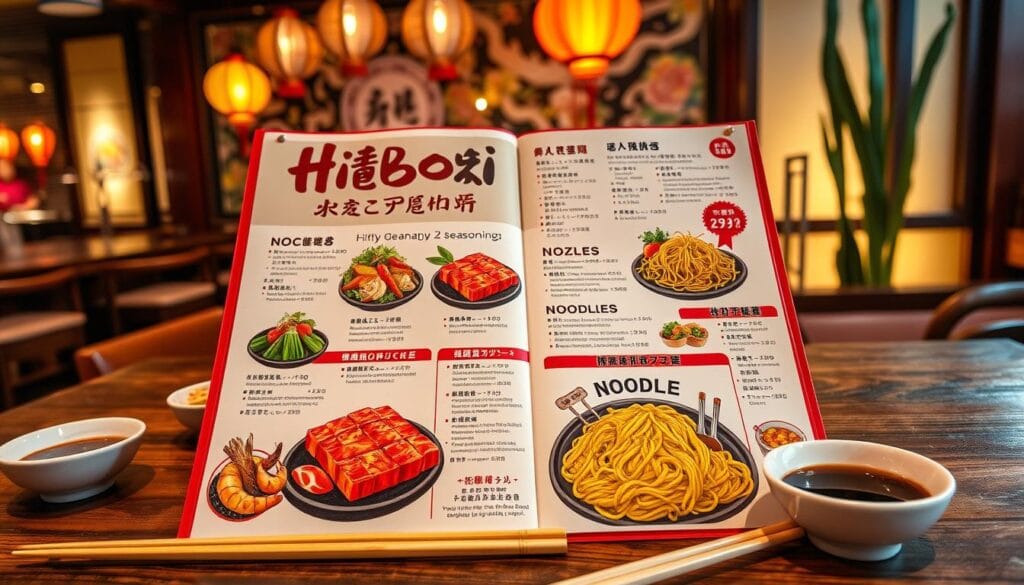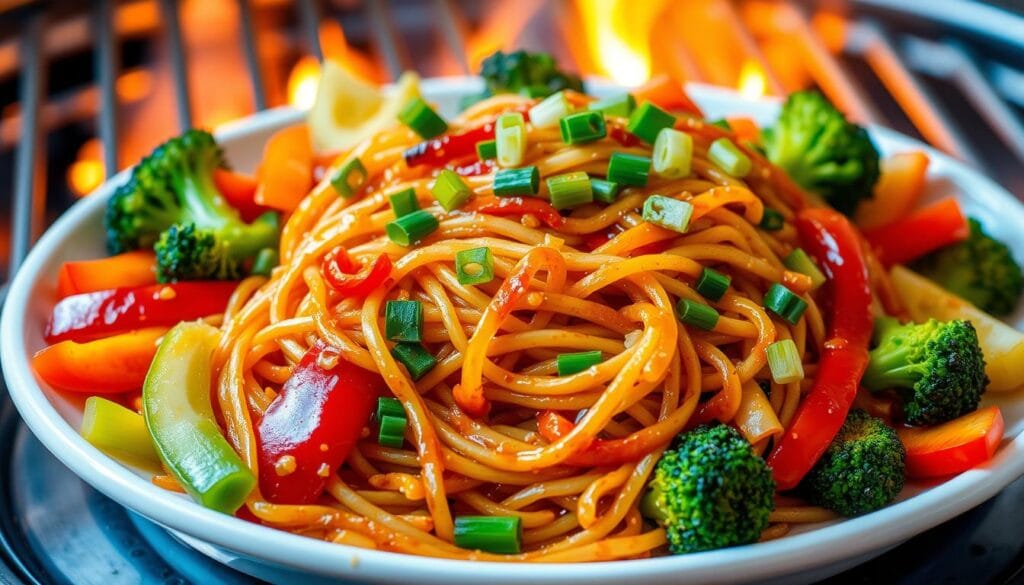Standing in front of the sizzling hibachi grill, I was hit with the smell of noodles, veggies, and sauces. It was like stepping into a Japanese steakhouse. The chefs’ skillful tossing of ingredients made the experience even more exciting. I knew I had to learn how to make these dishes at home.
Whether you’re a pro in the kitchen or just starting out, making Japanese stir-fried noodles is a game-changer. From yakisoba to linguine, there’s a wide range of hibachi noodles and teppanyaki noodles to try. Let’s explore the key ingredients, cooking methods, and tips to make your Japanese stir-fried noodles taste like they’re from a restaurant.
Table of Contents
Understanding Traditional Japanese Noodle Varieties
In the world of Japanese hibachi cuisine and teppanyaki noodle dishes, noodles are crucial. Yakisoba noodles are the top pick for these exciting dishes.
Yakisoba Noodles: The Classic Choice
Yakisoba noodles are made from wheat and have a chewy texture. They’re perfect for the bold flavors and quick cooking of Japanese hibachi cuisine and teppan noodle dishes. These noodles soak up sauces well, enhancing the taste of the dish.
Alternative Wheat-Based Options
While yakisoba noodles are the go-to, other wheat-based noodles like linguine can also work. They might change the texture and taste a bit, but still offer a great teppanyaki experience.
Specialty Asian Noodles for Teppanyaki
There are many Asian noodles beyond wheat-based ones. For teppanyaki, you can try rice, buckwheat, or starch-based noodles like glass noodles. They can add unique textures and flavors to your dishes.
| Noodle Variety | Characteristics | Suitability for Teppanyaki |
|---|---|---|
| Yakisoba | Wheat-based, slightly chewy texture | Excellent, the traditional choice |
| Linguine | Wheat-based, long, thin, and firm | Good substitute for yakisoba |
| Udon | Thick, chewy wheat-based noodles | Suitable, adds a unique texture |
| Soba | Buckwheat-based, delicate and nutty flavor | Suitable, provides a distinct taste |
| Rice Noodles | Made from rice flour, light and airy | Suitable, offers a different mouthfeel |
| Glass Noodles | Transparent, starch-based, and delicate | Suitable, adds visual interest |
“The key to creating an authentic Japanese hibachi cuisine or teppanyaki experience lies in the careful selection and preparation of the noodles.”
Essential Characteristics of Hibachi Noodles
Creating tasty hibachi-style noodle dishes starts with knowing the noodles’ key traits. They should feel slightly chewy and be cooked just right. These noodles are mixed with fresh veggies and protein, all seasoned with a sweet and savory sauce.
Hibachi noodles must handle the high heat of cooking well. They should be strong but also soft enough to soak up flavors. This mix is what makes the sizzling noodle platters so special.
“The key to exceptional hibachi noodles is finding that sweet spot between chewiness and tenderness, where the noodles can stand up to the intense heat of the grill while still being able to soak up all the delicious flavors.”
Whether you’re dining out at a hibachi steakhouse or cooking at home, knowing the noodles’ traits is key. It’s the base for making a dish that’s both authentic and delicious.
Perfect Noodle Preparation Techniques
Creating delicious hibachi noodles or Japanese stir-fried noodles starts with the right preparation. The goal is to get the noodles just right – not too soft, not too hard. By following a few easy steps, you can make your noodle dishes taste like they’re from a restaurant.
Proper Cooking Times
Cook your noodles as the package says, avoiding overcooking. For 16 ounces of spaghetti, cook for about 18 minutes. Then, drain and rinse with cold water. This stops the cooking and keeps the noodles firm.
Al Dente Consistency Tips
- Check the noodles a minute or two before they’re done to see if they’re al dente.
- When they’re almost done but still have a bit of chew, they’re perfect for your hibachi noodle dish.
- Don’t let them get too soft and mushy. This can make your dish unappetizing.
Pre-cooking and Storage Methods
You can pre-cook noodles up to 3 days ahead and keep them in the fridge. But, the best hibachi noodle dishes are made fresh. This way, the noodles will taste better and have a better texture. Just toss the pre-cooked noodles with your other ingredients and seasonings when you’re ready.
Learning how to prepare noodles well lets you make Japanese stir-fried noodle dishes that are just as good as your favorite hibachi restaurant. The key is to cook them right, keep them al dente, and use smart pre-cooking methods. These steps are essential for making truly great hibachi noodles.
Authentic Hibachi Noodle Seasonings and Sauces
Creating delicious hibachi noodle dishes starts with the right mix of seasonings and sauces. At the core is Kikkoman® Soy Sauce, known for its deep, umami flavor. This soy sauce is traditionally brewed and aged for months. It gives a unique taste that’s key to any hibachi dish.
Other important ingredients include brown sugar, garlic, and ginger. Together, they make a savory-sweet sauce that covers the noodles in flavor. Adding a bit of sesame oil at the end adds a fragrant finish.
| Ingredient | Quantity |
|---|---|
| Kikkoman® Soy Sauce | 1/4 cup |
| Kikkoman® Teriyaki Marinade & Sauce | 1/4 cup |
| Brown Sugar | 2 tablespoons |
| Garlic, minced | 1 tablespoon (about 4 cloves) |
| Ginger, grated | 1 teaspoon |
| Sesame Oil | 1 tablespoon |
This mix of salty, sweet, and umami flavors is what makes hibachi dishes special. It’s the base for a great hibachi menu or a tasty yakisoba noodle dish at home. With the right seasonings and sauces, your hibachi noodle dishes will taste amazing.

Making Restaurant-Style Hibachi Noodles at Home
Want to taste the yummy, caramelized flavors of hibachi noodles at home? You can! Make these tasty teppanyaki noodles in your kitchen. With the right tools and a few steps, you’ll have restaurant-quality noodles soon.
Required Kitchen Equipment
- Large wok or skillet
- Wooden or metal spatula
- High-heat resistant cooking oil
Step-by-Step Cooking Process
- Get all your ingredients ready – slice veggies, measure sauces, and cook noodles to al dente.
- Heat your wok or skillet until it’s very hot. Add oil and stir-fry veggies until they’re just tender.
- Add cooked hibachi-style noodles and stir-fry until they char and caramelize.
- Make a well in the noodles and add sauce ingredients. Stir until the noodles are coated and the sauce thickens.
- Take it off the heat. Drizzle with sesame oil and sprinkle green onions for that real teppanyaki noodle taste.
Professional Chef Tips
For the best taste, use a very hot pan or wok for that char on the noodles. Let them sizzle and brown for that caramelized flavor. Also, taste and adjust seasonings to get the perfect mix of sweet, savory, and umami.
| Ingredient | Amount |
|---|---|
| Yakisoba or lo mein noodles | 1 lb |
| Butter | 3 tbsp |
| Garlic, minced | 2 cloves |
| Soy sauce | 4 tbsp |
| Oyster sauce | 1 tbsp |
| Worcestershire sauce | 1/2 tbsp |
| Salt | 1/8 tsp |
| Ground black pepper | 1/8 tsp |
| Green onions, chopped | 2 stalks |
| Sesame seeds | 1 tbsp |
Follow these steps and tips to make delicious hibachi-style noodles and teppanyaki noodles at home. Enjoy your tasty dish!
Best Vegetables and Proteins for Hibachi Noodle Dishes
Choosing the right vegetables and proteins is key for a great hibachi noodle dish. They should match the hibachi noodles flavors and look good. This makes for a fun and satisfying meal.
Zucchini, broccoli, and mushrooms are top picks for hibachi noodles. They add color and texture. They also balance the dish’s flavors well.
Bell peppers and onions add a sweet and savory touch. They pair well with the hibachi noodles. This mix creates a tasty contrast.
Chicken breast is a classic choice for hibachi noodle dishes. But, you can also try tofu, pork, steak, or shrimp. This lets everyone find something they like.
Make sure all ingredients are small and easy to eat. This makes the dish look good and taste better. It also makes it fun to eat.
| Ingredient | Percentage | Cooking Time | Nutritional Information (per serving) |
|---|---|---|---|
| Yellow Squash | 50% | ~10 minutes | 128 calories, 9g carbs, 3g protein, 10g fat, 344mg sodium, 2g fiber, 5g sugar, 326IU Vitamin A, 24mg Vitamin C, 30mg calcium, 1mg iron |
| Zucchini | 25% | ~10 minutes | 128 calories, 9g carbs, 3g protein, 10g fat, 344mg sodium, 2g fiber, 5g sugar, 326IU Vitamin A, 24mg Vitamin C, 30mg calcium, 1mg iron |
| Mushrooms | 12.5% | ~10 minutes | 128 calories, 9g carbs, 3g protein, 10g fat, 344mg sodium, 2g fiber, 5g sugar, 326IU Vitamin A, 24mg Vitamin C, 30mg calcium, 1mg iron |
| Onions | 12.5% | ~10 minutes | 128 calories, 9g carbs, 3g protein, 10g fat, 344mg sodium, 2g fiber, 5g sugar, 326IU Vitamin A, 24mg Vitamin C, 30mg calcium, 1mg iron |
Pair the vegetables with hibachi noodles and serve with yum yum sauce. This makes a complete Japanese meal. Leftovers can be kept in the fridge for 3 days. Reheat them on the stovetop, in the microwave, or air fryer for a quick meal.

Common Mistakes to Avoid When Cooking Hibachi-Style Noodles
Cooking hibachi noodles at home can be fun and rewarding. But, it’s key to avoid common mistakes. Understanding temperature, seasoning, and texture can make your noodles taste like they’re from a restaurant.
Temperature Control Issues
Getting the temperature right is crucial for perfect hibachi noodles. If you overcook them, they become soft and gooey. If you undercook, they’re chewy. Make sure your wok or skillet is hot before adding noodles. Keep the heat steady while stir-frying.
Seasoning Balance Errors
Getting the flavors right is important for a tasty hibachi noodle dish. Don’t overdo it with one flavor, like too much soy sauce or garlic. Mix soy sauce, rice vinegar, sesame oil, and more to get a balanced taste.
Texture Problems and Solutions
The right texture is key for hibachi noodles. Too many noodles in the pan can make them soggy. Cook them in batches to let them sear and caramelize. Cook them until they’re al dente to avoid mushiness.
Mastering these techniques will help you make hibachi noodles and Japanese stir-fried noodles as good as your favorite restaurants.
“The key to perfect hibachi noodles is finding the right balance between temperature, seasoning, and texture. With a little practice, you can recreate the magic of a hibachi grill right in your own kitchen.”
Health Benefits and Nutritional Information
Hibachi and teppanyaki noodle dishes are more than just tasty. They can be a healthy meal choice if made right. This is thanks to the right ingredients used.
These dishes often feature lean proteins like chicken, beef, or seafood. These proteins are key for muscle growth. The quick cooking method also keeps veggies full of vitamins and minerals.
Grilled veggies add fiber and antioxidants to hibachi noodles. They also help with digestion. This mix of protein and veggies boosts health and well-being.
But, watch out for the sauce and oil. Many hibachi places use soy sauce, which is high in sodium. They also use vegetable oil, which is high in calories and fat. Choose low-sodium soy sauce and use less oil to make it healthier.
| Nutrient | Hibachi Noodle Dish | Recommended Daily Intake |
|---|---|---|
| Calories | 400-800 calories | 2,000 calories (average adult) |
| Protein | 20-40 grams | 46-56 grams (average adult) |
| Carbohydrates | 40-80 grams | 130 grams (average adult) |
| Fat | 10-20 grams | 44-78 grams (average adult) |
| Sodium | 800-1,500 milligrams | 2,300 milligrams (maximum recommended) |
To pick the healthiest hibachi or teppanyaki noodle dish, choose whole-grain noodles. Load up on veggies and pick lean proteins. This way, you can enjoy the flavors while staying healthy.
Conclusion
In conclusion, hibachi noodles and teppanyaki noodles are loved for their tasty mix of noodles, veggies, and proteins. You can try different noodles, like wheat-based ones or Asian noodles, to make your own Japanese stir-fried noodle dishes.
The secret to great hibachi noodles is in how you prepare them, season them, and cook them. With a bit of practice, you can make these dishes at home. Focus on getting the noodles just right and using real Japanese seasonings and sauces.
Whether you stick with traditional yakisoba, try new noodles, or mix up the proteins and veggies, hibachi noodles let you make your meal your own. You can bring the lively tastes of Japan right to your kitchen. Dive into the world of hibachi cooking and enjoy the tasty adventures ahead.

